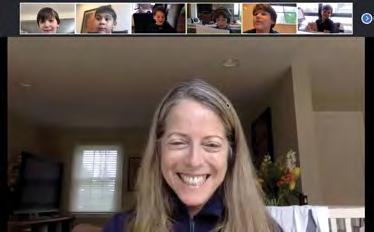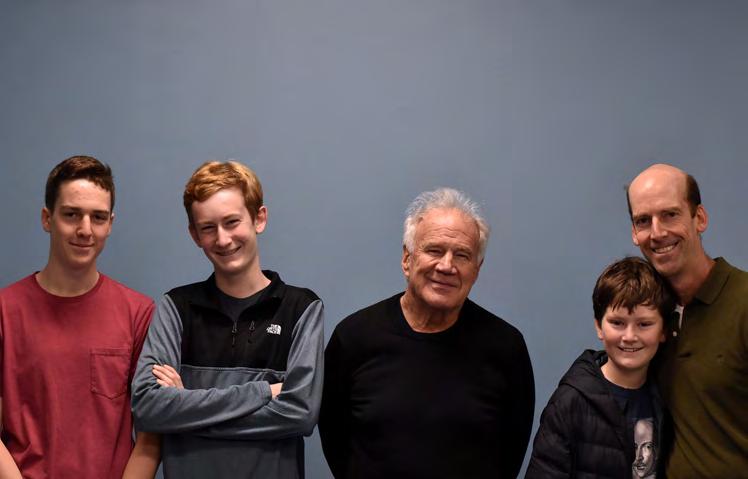
16 minute read
Alumni Features
alumni spotlight alumni spotlight
HENRY FAMILY INTERVIEW
History Teacher and Alumni Liaison David Kersey h’98 sat down with some members of the Henry Family, John Henry ’84, Ryder Henry ’17, Jay Henry ’20 and Will Henry (6th Grade) to speak about their family legacy at Allen-Stevenson.
David Kersey: Starting the Henry Family Legacy at Allen-Stevenson in the 1920s, we have Ryder Henry, II ’23 and Clement S. Henry ’23, John’s father’s cousins. And then your dad, John Campbell Henry ’28.
John Henry ’84: My direct grandfather was named Ryder Henry who had my father John Campbell Henry ’28 and a daughter, my Aunt Louise. My grandfather also had a brother with two sons, Clem and Ryder. My Dad and his cousins all went to AllenStevenson.
DK: Where did your aunt go to school, I wonder?
JH: I think she went to Chapin. My sister went to Chapin, so I’m assuming my aunt did too.
DK: Before Allen-Stevenson moved to the Upper East Side in the 1920s, those two schools were next to each other on 57th Street, in Marble Row. They also share the same motto ‘Fortiter et Recte’.
JH: My Dad used to live in the 70s and then moved up to 93rd Street with my mom. My brother Eric Knaus ’73, who went to Allen-Stevenson, came to live with us there when he was 10. My mom, Annemarie Henry, married her first husband Ronnie Knaus, Eric’s father, in Madrid in 1956 or 1957. Ronnie was flying spy reconnaissance missions during the Korean War. It was super interesting because my mom was this statuesque beautiful woman from Norway, and they thought she was a spy for a long time. So, they have Ronnie who is flying fighter jets in the war, and everyone thought he was possibly married to a spy.
I’m not exactly sure the full details of this, but Ronnie was shot down and believed to be MIA and dead. My mom decided to move away from Palm Beach to Georgia. And then Ronnie appeared—he was shot down, but he was still alive. My mom at that point, it was a year or so later, had moved on. Ronnie went back to Texas, where he was from, with my brother Eric. At the same time, my mom moved up to New York, met my dad John Campbell Henry ’28 and eventually got Eric to come live with them. They enrolled Eric at Allen-Stevenson when he was 10, probably around 1969. DK: So, you and your brother Eric lived together?
JH: Yes, we did. But after 8th Grade he went off to boarding school at St. Mark’s, when I was only four, so I just remember him coming back on holidays and vacations. Eric is in Houston, TX now. His work involves telecommunications installations.
Jay Henry ’20: You know, this is all really cool to hear about your mom and Uncle Eric. I’ve never heard these stories before.
Jay: I didn’t know most of this honestly. All I knew was that Eric and our grandfather went to AllenStevenson – I didn’t really know that we had such a long legacy here.
JH: Okay, so we had three Henrys from the 1920s: Ryder Henry, II ’23 and Clement S. Henry ’23 who are possibly twins and my dad, John Campbell Henry ’28. Then there was my brother Eric Knaus ’73 and my cousin Winfield Vans Murray Henry ’79, then me.
DK: John, how did you decide to send your kids to Allen-Stevenson? Was there much of a choice?
Will Henry (6th Grade): It was mom!
JH: Well, I mean, I don’t want to say we didn’t have a choice, but there are so many great things about Allen-Stevenson. When we were going through the whole process, one of the schools we looked at was mostly focused on athletics. Although I consider us an athletic family, I don’t think that’s the only thing we’re excited about.
There are plenty of great schools, but I think AllenStevenson really creates a Machiavellian type of individual who can excel at everything—academics, athletics and the arts. I think that really sets AllenStevenson apart from any school that I know of and for me it was being in the orchestra and playing the oboe…
Jay: …and being in Gilbert & Sullivan…
JH: Yea, I don’t think you can really get that opportunity anywhere else. We certainly weren’t seeing that opportunity at other schools. That’s another thing about Allen-Stevenson, I’m not sure exactly how, but they know how to teach a boy. You have to know how to do that—it’s a special thing. Allen-Stevenson does that better than anyone. One of my good friends from Allen-Stevenson, Philip Utsch ’84, his brother went to a different school and he totally missed out on the arts.
DK: So that’s something that comes along with the School—those friendships.
Jay: I think because of the smaller class size and because we’re with the same people for sometimes ten years, it creates a strong, tight-knit community. The teachers also know each student well so it’s not that one student gets left out. It elevates the experience because you have a sense of community and a lot of support.
DK: Have all of you performed in a theater production at Allen-Stevenson?
Jay: Yup! I was part of the chorus from 4th through 8th Grade and I did all of the plays.
WH: I was in the most recent Gilbert & Sullivan performance, Pirates of Penzance.
Ryder Henry ’17: I did Gilbert & Sullivan every year and I was in orchestra in Middle School and chorus in Upper School.
DK: What motivated you all to do Gilbert & Sullivan?
Jay: All of my friends did it in Fifth Grade, so it was a big thing. Also, doing the class plays in Lower School, helped me become more comfortable with being on stage and performing. I also loved doing Mr. America—I was Hawaii and Alaska.
RH: I was New York. I worked on that accent for a while. Fuh-get about it!
WH: I was Arizona, which is a very interesting state.
What are some of your fondest memories at AllenStevenson?
JH: I don’t think you boys know this, but in Fifth Grade, we had an encaged roof at the top of the School. We started playing dodgeball—I’m not sure when Mr. Kersey started overseeing us, maybe in Sixth Grade. And the great thing about our class is that we took dodgeball to the next level. Normally in dodgeball, you have a line between the two teams. We ended up creating a game called Scatterball, which is loads more violent than dodgeball. You wouldn’t have that line dividing the teams. It turned into an individual game where you could take three steps and throw the ball at whoever was closest to you. Then we tried to have teams, so you’d take three steps and pass the ball to a teammate with a bounce pass, then he would get three more steps. You would target someone together, so once you got close to someone the teammates would throw the ball as hard as they could at someone. It was our own version of Lord of the Flies.
DK: The way the game was played, by the way, you could come back in when the guy who knocked you out lost. JH: What was so nice was that we had to get our energy out. It was a great thing that Mr. Kersey let us do—and I don’t think anyone had to go to the hospital! I remember coming home with holes in my pants, ripped clothes and missing buttons. My mom had no idea why.

Jay: I remember a lot of the field trips, especially the one that Will just went on to Philadelphia.
RH: I have really great memories playing on the roof. There was the enclosed area, but there was also an open area where people used to play football. I remember the countless balls, shoes, and articles of clothing that went over the edge.
Jay: I also loved my fifth-grade class. We invented this hockey game with goalies and forwards to play in the classroom. We had a full league with 15 named teams like the Las Vegas Casinos and the San Francisco Seals. We had full tournaments too. We even started to trade players. That year in school we had unicorn dollars and a unicorn bank for our class. We would get them for doing something good in class and trade them in for candy. But it got to the point where people had millions of unicorn dollars and there were moguls who were trading players for their team. We also had our own bank managing the money, but it was corrupt— we had a full unicorn economy!
DK: What do you think John Campbell Henry ’28 would think about his grandsons all going to AllenStevenson?
Jay: I think he would be proud because we’re all coming back. It’s a great way to acknowledge and remember the older generations of Henrys that went here.
RD: I think they would see it as a sense of accomplishment.
JH: I would say they would be proud.
DK: Well, the Henrys to me represent a kind of tradition—a school needs new people coming in, but it also needs old families. When you measure a school that way, I think the Henrys have made a great contribution to the School—not just them being here, but the kind of family they are. That has always been very important to me. So, I think it’s important you’re here, Will. And it’s important your brothers were here and your Dad.
alumni spotlight PANG LEE ’90 Corporate Lawyer
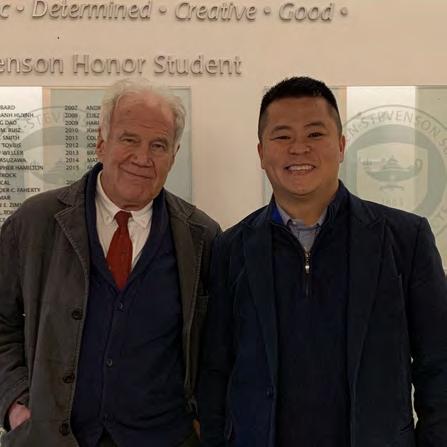
Corporate Lawyer, Pang Lee ’90, currently works at Cooley LLP in Shanghai with his wife and three children. After attending P.S. 42 in the Lower East Side, Pang moved to Allen-Stevenson in Seventh Grade as a Prep for Prep Student. His A-S teachers had a huge influence on his life, including Headmaster Desmond Cole, who encouraged Pang to attend boarding school. After Allen-Stevenson, Pang went on to Phillips Exeter Academy and then college at Massachusetts Institute of Technology. Although Pang studied biology in college and had aspirations of attending medical school, his college advisor sat him down his senior year and told him that his talents may lie elsewhere (but didn’t tell him where!). It felt like a set back at the time, but Pang heeded what turned out to be invaluable advice. After college he worked in consulting for a few years, spent a year giving back by working at Prep for Prep, and then started law school at the University of Pennsylvania.
After law school, Pang returned home and started his career at Paul, Weiss, Rifkind, Wharton & Garrison LLP, a large New York City law firm. He sees his career path as pretty traditional, but his time as a lawyer has taken him on an unexpected adventure around the world. After practicing in New York, he received an offer to work at a law firm in Hong Kong, so he moved there with his wife Kity, settled down and had three children. After seven years in Hong Kong, he had another opportunity to join his current firm, Cooley LLP, so he moved to San Francisco, where he spent two years before landing in Shanghai, where he’s currently been for the past six years.
As a corporate lawyer, Pang works with investors and fund managers putting together the legal arrangements for investment funds that invest in start-up companies both in China and the United States. He enjoys what he does because of his personal history straddling the two countries and working in a rapidly modernizing China. His family left China, at the time, a socialist economy, to live in New York City nearly 45 years ago. When he was a child, Pang recalled spending time in China with his grandmother who lived in much darker era in China’s history. On one particular visit, he vividly recalled that she was celebrating because she figured out a way to get an electric wire connected to her shanty to get a single light to shine. He thought it was strange because back in New York, electricity and all the great things that came with it was plentiful. He compares his job as a funds lawyer to this example—he was part of an early group of US educated funds lawyers that helped create the market for private capital to flow into emerging companies in China—so he’s kind of like a wire maker for investors and aspiring entrepreneurs who need funding... Sounds fairly ho-hum in the US, but for a place like China, this type of work and activity was still illegal when he was a kid.
Pang feels that his time at Allen-Stevenson was the first step in opening up to the wonderful opportunities and experiences that the bigger world has to offer. The School gave him access to his full educational journey. He fondly remembers many of
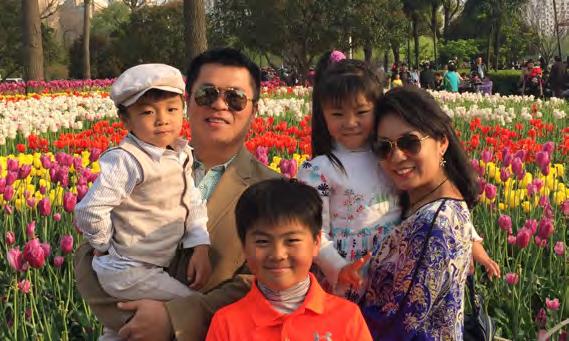
his teachers, including Mr. Pariseau, Mr. Cohen and Mr. Kersey. He notes that the distinguishing qualities in his A-S teachers were that they were always encouraging, creating a nurturing space for him to blossom. And with three children of his own, he thinks at that age, that’s exactly what you need— encouraging boys in all types of ways whether it be in academics, arts or athletics.
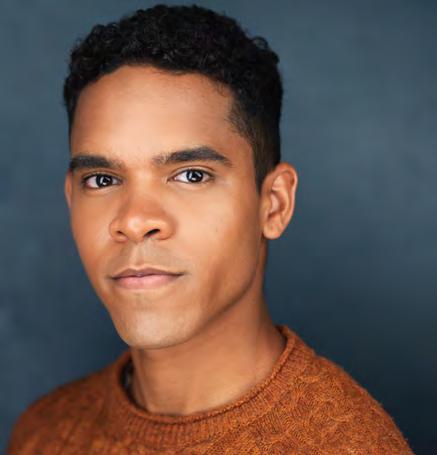
ALEX BARTNER ’10 Actor
Alex Bartner ’10 is currently an actor living in New York City with aspirations in theater, film and television. During his time at Allen-Stevenson, he was in the Chorus for two Gilbert & Sullivan performances, The Mikado and Patience. When Alex went off to Columbia Grammar & Preparatory School, despite his shy nature, he decided to try an acting class and he was hooked. He continued to love acting in plays throughout high school, which motivated him to go to a four-year conservatory program at New York University Tisch School of the Arts. He graduated in 2017 with a BFA in acting and since then he’s been continuously auditioning for roles in addition to his ’survival job’ at a private arts club.
So far, Alex has appeared in web series (Konnect 212) and commercials, performed in immersive productions (The Unbrunch), and co-starred in an upcoming Shonda Rhimes Netflix Series ( Inventing Anna ). But Alex’s favorite role was playing Tullus Aufidius in college in a production of Coriolanus, a very lengthy Shakespeare play. It was the culmination of all of his training -voice and speech classes, a Shakespeare class, and movement classesand he even learned how to use a sword! It’s still the performance that he is most proud of today.
Alex remembers his time at Allen-Stevenson fondly and recognizes the importance that his time at the School had on his career. Being a part of Gilbert & Sullivan allowed him a unique opportunity to stand in front of an audience and perform at a young age. Without that experience, he claims he would have been terrified to perform in high school—and might have missed out on his true passion.

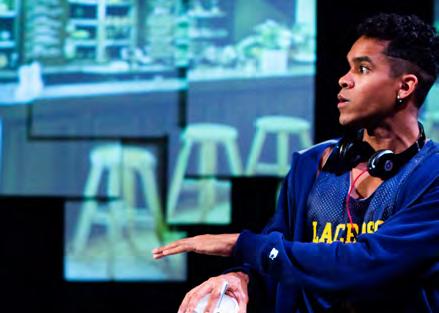
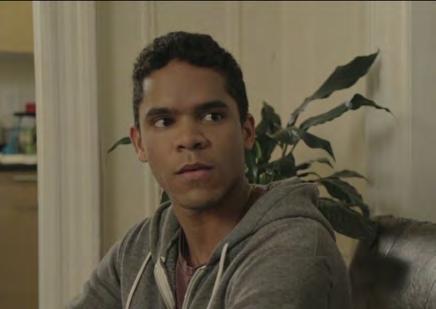
STAYING CONNECTED TO THIS WARM AND WELCOMING COMMUNITY The Jones/Everett Family
We loved that the Headmaster greeted every boy outside the School.

Can you describe how Gus and your family ended up at Allen-Stevenson? Gus was at Allen-Stevenson from 1999-2002 (Kindergarten through 2nd Grade).
As a British boy growing up in New York we wanted Gus to have both an excellent education and an experience of the unique cultural diversity of the city. We visited a number of schools and Gus was fortunate to be offered a place at several. We chose Allen-Stevenson because of the tremendous welcome we received, the evident excellence of the teaching and facilities and the warmth and openness of the whole school family.
What is Gus’ favourite memory or experience from his time at Allen-Stevenson? Gus was always very sociable and energetic. He was enthusiastic about most things, particularly sport and science. He also liked to make things. His happiest moments were experiments in the science labs; playing basketball, baseball and flag football which began a life-long passion for American football, and building things in the workshop. He loved playing with his class-mates and remembers fondly Mrs. Matthew’s school lunches.
When we told Gus that we were moving back to the UK he said that would be fine as long as he could get the Concorde to New York every day to keep going to Allen-Stevenson.
As parents, what did you and Chris find to be so special about Allen-Stevenson? As parents we felt that we were as much a part of the School as the boys. We really appreciated how much the parents were involved in every part of school life. We could live the experience as much as Gus did. I (Sara) often wished that I could come to school Gus working as a healthcare every day instead of having to go to work! assistant in the COVID-19 wards at the John Radcliffe Hospital in Oxford, England. We valued highly Allen-Stevenson’s open and inclusive culture and its commitment to supporting the local community. I (Sara) remember well being part of the neighbourhood patrol group and Gus and I, with other Allen-Stevenson families, cooking huge quantities of meat loaf in a nearby shelter for homeless people. alumni spotlight We respected greatly the immense generosity of former students, their families and Allen-Stevenson’s many supporters and the awe-inspiring fundraising skills of both parents and teachers. Why do you continue to stay connected to the School? Although Gus spent only three years in the School these were very important years in a young person’s education. Gus had the good fortune to begin his formal education at Allen-Stevenson, which gave him a strong grounding, not just in academic subjects but We have no doubt that Gus’s years at particularly in the values of respect for others and treating everyone as equal.
Allen-Stevenson taught him to love learning, aim high and believe in himself.
Gus went on to the Dragon School in Oxford, England; Eton College and Oxford University where he gained an undergraduate degree in biology. After a period as a professional rugby player, having played for the England rugby team including in the 2014 Junior World Cup championships which the England team won, Gus undertook a master’s degree in neuroscience at University College, London which he passed with distinction. He is now back at Oxford University studying graduate medicine.
Gus Jones, Sara Everett and Chris Jones
We are immensely grateful to David Trower and all the teachers and staff at AllenStevenson for the inspiration, warmth and friendship they gave Gus and continue to give us all today. We look forward to continuing our close links with Allen-Stevenson in the years ahead.
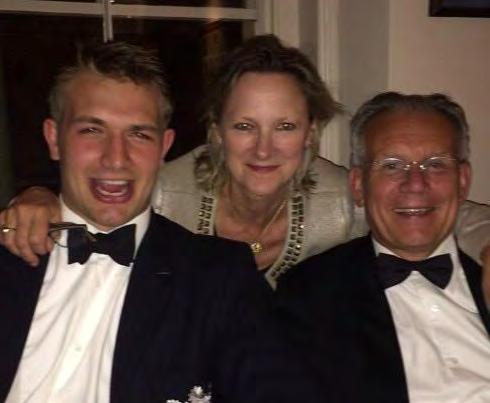
Gus Jones, Chris Jones and Sara Everett 4 March 2020






